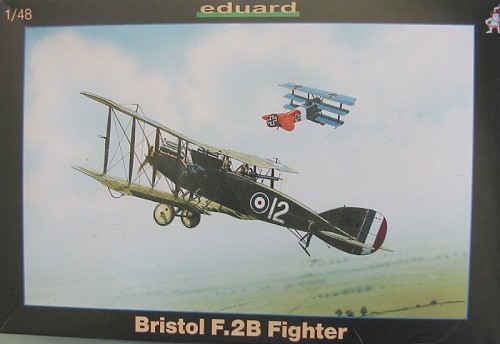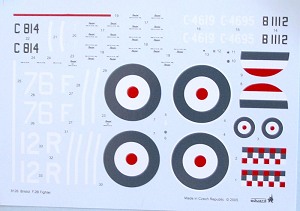
| KIT: | Eduard 1/48 Brisol F.2B |
| KIT #: | ? |
| PRICE: | $29.95 MSRP |
| DECALS: | Four options |
| REVIEWER: | Tom Cleaver |
| NOTES: |

| HISTORY |
Easily the best two-seater used by any of the combatants in the First World War, the Bristol Fighter was originally designed and flown as the F.2A in 1916 as a proposed replacement for the awful B.E.2 series, then being shot down in flocks over the Western Front by such pilots as Manfred Von Richtofen, for whom the B.E. was “meat on the table.”
First appearing on the Western Front in April 1917, the Bristol F.2B Fighter nearly came a cropper in its first combat, where its pilots - schooled in the defensive flying used for 2 seat reconnaissance aircraft and believing that the airplane was as fragile as it looked, with both upper and lower wings attached to the fuselage by cabane struts - failed to use it as it had been designed. The second squadron to take the airplane into combat, having had more time to become familiar with their mounts, knew that the airplane could be thrown around the sky with abandon, with never a thought of potential structural failure. My father told me of seeing Art Goebel, a famous air show aerobatics pilot of the 1920s and 30s, who did his show in a Bristol Fighter that took second place to no one with its agility.
The F.2B was not a traditional 2-seater. It was as its name said, a fighter. The lower wing was attached in the manner it was so that the upper wing could be lowered to give both pilot and observer good vision and a wide angle of fire - the observer being able to fire in a full 360 degrees - while maintaining the proper aerodynamic separation between the wings. With its single forward-firing Vickers mounted directly over the engine, there was never any trouble with the weapon freezing up at altitude, as was wont to happen with other airplanes. Fully as maneuverable as any single-seater, the Germans soon learned that they needed a full Jasta of 9 fighters to bring down two Bristol Fighters working in cooperation.
More than 50 rear seaters became “gunner aces” in Bristol Fighters, while several pilots - such as the Canadian Andrew McKeever, top-scoring Brisfit pilot with 30 victories, and New Zealander Keith Parks with 22, were among the top-scoring pilots of the RFC and RAF.
The Bristol Fighter soldiered on at the frontiers of empire until it was finally retired from operational service in 1934, long after all its original contemporaries had been consigned to the scrap heaps.
There is one original Bristol Fighter still flying in the United Kingdom under the auspices of the Shuttleworth Collection, while Peter Jackson, director of the “Lord of the Rings” trilogy and a long-time collector of World War I airplanes, has a very accurate modern replica Bristol Fighter that wows crowds at air shows in New Zealand.
| THE KIT |
 It
wasn’t that long ago that there were no 1/48 kits of the Bristol Fighter
available, and now there have been four in the past six years, each just a
bit different from the others. Of course, the Brisfits by Blue Max and
Aeroclub - being limited-run - are long out of production, though they make
into excellent models if you can find them, and the fabric wing rib detail
of the Blue Max kit is the best of any of the kits - this kit is also the
only one to provide the different cowling and radiator for the
Eagle-powered variant. This new kit by Eduard joins the Roden Bristol
Fighter released last fall as one of the two injection-molded kits of this
famous airplane.
It
wasn’t that long ago that there were no 1/48 kits of the Bristol Fighter
available, and now there have been four in the past six years, each just a
bit different from the others. Of course, the Brisfits by Blue Max and
Aeroclub - being limited-run - are long out of production, though they make
into excellent models if you can find them, and the fabric wing rib detail
of the Blue Max kit is the best of any of the kits - this kit is also the
only one to provide the different cowling and radiator for the
Eagle-powered variant. This new kit by Eduard joins the Roden Bristol
Fighter released last fall as one of the two injection-molded kits of this
famous airplane.
Comparing the two, the Roden kit - to me - has the more accurate-looking
fabric surfaces. The Eduard kit has the too-stylized rib detail of their
Sopwith Camels. However, since the Camels look fine under a coat of
paint, I am sure the same will
 be true with this
kit.
be true with this
kit.
This particular kit is the non-Profipack version, so it does not have the photo-etch detail and items like seat belts that the other - more expensive - Profipack version will have. That said, when comparing the detail here with that of the Roden kit - which also lacks those photo-etch parts - the Roden kit looks fine and I am sure this kit will too.
The decals are the one place where Eduard made a mistake, with the colors of the national insignia being a too-dark blue more like that of the World War II national insignia. Most modelers who are not serious WW1 purists will not have any problem with this, and the serious WW1 purists most likely have accurate decals available.
| CONCLUSIONS |
Overall, this is an airplane for someone with several biplane models to their credit, because of the complicated assembly of the wings, and the extensive rigging that is so necessary to creating the right “look” to the finished model. Eduard has provided good raw material here for a modeler to demonstrate their mastery of the subject matter.
Egad! I am about to end up with an entire air force of Bristol Fighters here before too long!!
May 2005
Thanks to Eduard for the review kit.
If you would like your product reviewed fairly and quickly by a site that has around 300,000 visitors a month, please contact me or see other details in the Note to Contributors.